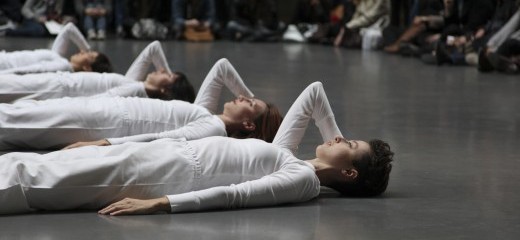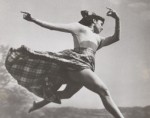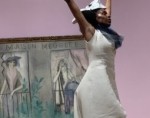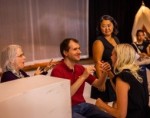
Photo: John Mallison
“Going Back to Nothing” - Kicking Off the Trisha Brown: In the New Body Festival
by Jonathan Stein
How in the space of an early fall afternoon can mind and body embrace the breadth of innovation of one of the great choreographers of the last half-century? Wendy Perron, a member of the Trisha Brown Dance Company in the '70s and past editor of
Dance Magazine, worked her magic to help us achieve this through lectures, classes, and performances. She introduced a multi-generational group of eager participants to Brown and her early post-modern explorations.
Perron’s passionate articulation of the beginnings of post-modern dance in the '60s and '70s in her talk at the University of the Arts (UArts), complemented by talks at Temple University and Drexel University, kicked off the year-long “
Trisha Brown: In the New Body” festival by reaching out to students and community members who don’t often venture from their academic enclaves. This well-planned series of offerings at a diverse array of venues was organized, in rare programmatic synchronicity, by Lisa Kraus, co-founder of thINKingDANCE and former Brown dancer, whose time in the company overlapped with Perron’s. A sisterly Wendy-Lisa dialogue punctuated the talks, sparkling with first-hand memories that served to fill in gaps in the historical record.
I have asked fellow participants Guillermo Ortega Tanus, Sheila Zagar, and Eun Jung Choi to join me in offering commentary on the experience of this Saturday afternoon at UArts.
__________________
Jonathan Stein:
In lectures accompanied by captivating, archival photo images, we experienced the giddy cauldron of innovation and experimentation that seeded Brown’s developing work. This later work landed on proscenium stages with large ensemble dances, some of which will be seen next week at Bryn Mawr (Set and Reset and PRESENT TENSE), and performed by the Pennsylvania Ballet in June (O zlozony/ O composite). Perron was especially adept at showing that Brown’s innovations thrived in fertile symbiosis with those of many others of the early '60s Judson Dance Theater, including Yvonne Rainer, Merce Cunningham, Steve Paxton, Simone Forti, Deborah Hay, and Lucinda Childs. Perron quoted Rainer who—countering the notion of a set Judson aesthetic— emphasized Judson’s diversity: a hundred performing artists creating and showing work. Perron’s Drexel talk on the Judson Dance Theater of 1962-64 showed the range of influence and diversity of somatic and conceptual experimentation in even that brief period.
In stripping dance of its historical baggage, the zany experiments in task dances and dance constructions of that time (e.g., Brown’s Walking on the Wall [1971] or Forti’s Slant Board [1961]) exhibited a joyful play. This infectious, liberating spirit reflected both a specific interest in children’s games—especially evident in Simone Forti’s work—but also permitted artists’ play to be seen as a viable source for improvisation in the body’s quest to re-discover itself.
Visual artists joined the fray by creating performance art that, unlike much of their traditional output, was not commodified for the marketplace. In Robert Rauschenberg’s Pelican (1965)—a title Perron reported was suggested to the artist by Brown—Rauschenberg donned an open parachute and wore roller skates, apparently to hide the fact he couldn’t dance. But, Perron added with a grin, he couldn’t roller skate either.
Perron aptly summarized the radicalism of Brown and her contemporaries at Judson as “going back to the beginning, going back to nothing,” and “not accessing acquired wisdom, erasing everything you know.”
In Perron’s class, students from Temple, UArts, and Headlong Performance Institute focused on the improvisational structure of Line Up (1977) and the graduated, repetitive assemblage of small movements of Accumulation (1971). But in the Judson spirit of multiple influences, Perron also wove into the class Forti’s Scramble exercise, a common warm-up in Contact Improvisation gatherings, which combines the pedestrian movements of walking and running in a setting of improvisational flux. An exercise in shared-weight partnering acknowledged the influence of innovators like Steve Paxton and Brown’s own fascination with weightedness, gravity, and falling. Indeed, in one of the archival images Perron referenced in her lecture, Brown seemed to be reveling in a slithering slide down Paxton’s inclined back.
Although the plan of the day was to bring our performances of
Line Up and
Accumulation somewhere beyond the UArts studio, Perron instead chose three sites in and around UArts Hamilton Hall.
Accumulation, especially, became a site-specific gem, as two groups lay in lines on their sides along the open balconies framing the Hamilton Hall atrium, a naturally lit space. At certain moments, legs suddenly extended through railings into the open atrium for observers below. Perron gently called out the sequential numbers of the 30-movement piece, a count that the Trisha Brown dancers internalized in all
Accumulation’s many variations: on small floating rafts, while being carried and re-positioned, while talking, etc. Beyond Perron’s voice, a meditational quietude enveloped the dancers and the space.
Line Up, set in the lobby and on the outside steps of Hamilton Hall, had four groups of dancers—following a wonderfully simple but fulsome instruction of “line up”— craft together responses to fellow dancers’ initiating movements, forming a sequence then set for repetition. All involved experienced the delight of being a part of this living Trisha Brown legacy.
_______________________________
Guillermo Ortega Tanus:
One aspect that I enjoyed was the simplicity of the movement together with the challenging of ideas.
I couldn't stop noticing the fervor ex-Trisha Brown's dancers have for her.
What was new about this "alignment" was that a simple idea created the entire score or choreography in a group format. In her lecture, when Wendy was talking about Spanish Dance, I noticed the same element of simplicity.
I also wondered about the idea of taking dance into the streets and the use of architecture. I feel it's something that is not explored enough. When we arrived to the UArts Hamilton Hall building, our presence and Wendy’s directions changed its energy—and instantly transformed it into a performance space.
I also felt the presence of history in the work we performed.
_______________________________
Sheila Zagar:
Wendy's lecture was inspiring, waking me up to new ways of thinking about dance and dance structures. I appreciated Trisha's interest in the horizontal visual landscape and how that affected her dance investigations as well as her internal movement desires: falling, buoyant folding, sliding off of backs. I came away with a feeling of joy.
Wendy is a generous, lovely teacher and she emanates a joy and excitement about the work of Trisha Brown. Each of Brown’s structures invited individuality while creating a sense of group, community. I am struck by how the transparency of process evokes an intimacy, a humanness.
Accumulation: Returning to the beginning and adding on is a satisfying and rewarding process. I was captivated moving inside the structure of building simple moves one body part at a time. It gave me time to feel the initiation and the end of a motion. This idea of repetition and adding on is one of my teaching tools, and it is exciting to see how the process of learning is structurally interesting to watch.
_______________________________
Eun Jung Choi:
I find it difficult to summarize my thoughts because my experiences and knowledge of Trisha Brown's work has been scattered over 23 years. I was introduced to Trisha Brown when I was in Korea. I learned about her as one of the postmodern pioneers of the Judson Dance Theater in dance history class in college, and I saw her short works at various sites including a benefit concert at Danspace Project and a Lincoln Center outdoor concert after moving to NYC in 1998.
Wendy Perron’s UArts lecture and workshop, including the performance we did afterwards, felt like the best summary of what I have known about Trisha Brown from different sources and artists. It gave me a clear picture of who she was as an artist, what she accomplished, how she challenged herself and engaged with herself and others as a choreographer. Perron’s chronological display of her works and descriptions of her artistic endeavors and interests helped to place her in the history of dance and showed how her influence has rippled throughout several decades.
Trisha Brown: In The New Body, lectures and classes with Wendy Perron, Sept. 29-October 13, University of the Arts, Temple University, and Drexel University. Upcoming performances, Oct. 18, 11 am and 2 pm,
Early Works at the Barnes Foundation;
Proscenium Works, 1979-2011, Oct. 23 and 24, 8 pm, and
Floor of the Forest, Oct. 24 5:30 pm and Oct. 25, 1 and 2:30 pm at Bryn Mawr College.
By Jonathan Stein
October 17, 2015







.png)


